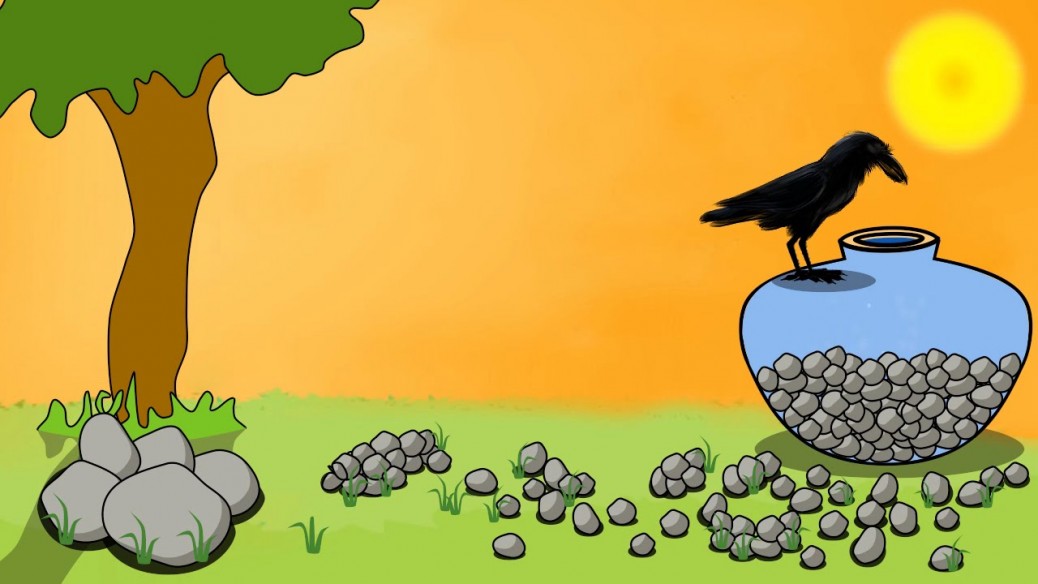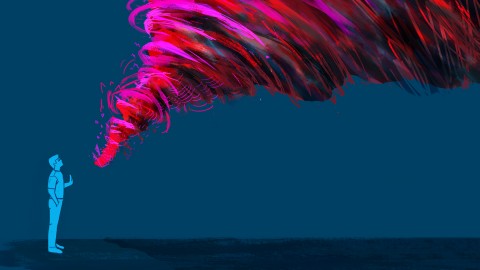One hot day, a thirsty crow flew all over the fields looking for water. For a long time, he could not find any. He felt very weak, almost lost all hope. Suddenly, he saw a water jug below the tree. He flew straight down to see if there was any water inside. Yes, he could see some water inside the jug!
The crow tried to push his head into the jug. Sadly, he found that the neck of the jug was too narrow. Then he tried to push the jug to tilt for the water to flow out, but the jug was too heavy.
The crow thought hard for a while. Then, looking around it, he saw some pebbles. He suddenly had a good idea. He started picking up the pebbles one by one, dropping each into the jug. As more and more pebbles filled the jug, the water level kept rising. Soon it was high enough for the crow to drink. His plan had worked!
Don’t React, Respond
We are seeing only our requirements of that moments and how to achieve that. We are in hurry to fulfill our requirements. So we are not able to see what insight is available in that moment from that circumstances and how that insight will become our light for joyful life.
Crow is thirsty, so he was looking for water. He found the water and pebble. He needs to use his own intelligence. Unless he use his own intelligence he cannot quench his thirst. It’s not about hard work it’s about smart work.
Anyone can do hard work. With all the available information everyone can work hard, but behind the hard work there is individual intelligence which is responsible for their success. All of you must have noticed in your life with same education background everyone achieve different things in the life. Many gold medalists are miserable failure. Why? Just because they have not used their intelligence.
Use every opportunity in life for raising your intelligence, your consciousness.
When we use our intellect with consciousness of present moment it is intelligence. In that circumstances we are responding and not reacting.
There is a huge difference between reacting and responding. A reaction is typically quick, without much thought, tense and aggressive. A response is thought out, calm and non-threatening. A reaction typically provokes more reactions – perpetuating a long line of hatefulness with nothing accomplished. A response typically provokes discussion – perpetuating healthy discussion (debate even) that leads to resolution.
Learning from the story, The Thirsty Crow: Don’t React, Respond
Experience Learning
There may be a slight difference between the words react and respond. Yet, in practice, there seems to be a gulf of difference.
React in action.
When people react, it seems to be defensive. We seem to be at a disadvantage. We are uncomfortable with what is being said or done, and we react. In our reactions, our emotions take a central role.
We know reactions when we see it. In fact, some people on the other side will intentionally stoke the fires, especially when they know we will react. They know if they poke we will coil up and be ready to react in a full way.
There is a downside to reacting. We let emotions without reason drive us forward. We lose control. Reacting is sporadic and emotional.
Respond in action.
On the flip side is respond. There is still an external spur to our response. Responding, though, is more thoughtful. Responses contain reasoning.
The difference may be this: Responding is guided less by emotion and more by logic.
Responding may be passive in nature, as we are going second in a series. However, a response is more active, and it can change the direction of an interaction.
The upside of a solid response is an engaging conversation, all positive and all civil. We learn. We grow. We listen. We respond. We act forthrightly and from within.
The mindfulness difference.
If mindfulness is being more centered within and aware of others, then this is a practice we need to embrace to prevent reacting and focus on responding.
Mindful outlines several articles to begin these routines. Let’s apply these mindfulness practices to responding. To respond in a more mindful way, these four steps may help:
Step 1: Breathing: Maintaining evenly-paced breathing is essential, an in and out reasonable rhythm. By focusing on our breathing, we will bring our thinking under control.
Step 2: Awareness of body: With each breath, we become more aware of our body. We bring our heat of the moment under control. With focus on our breathing, we also bring our body into a steady state as well, calming our systems down.
Step 3: Releasing tension: With each breathe and raised awareness, we bring ourselves into control and release tensions.
Step 4: Raising attentiveness: As we maintain our inner calmness and strength, we listen to what is being said more intently, and we watch the way in which it is being said. We become more aware as we formulate our response. Our raised attentiveness enables us to respond more thoughtfully and, if needed, begin to direct the exchange in a direction of collaboration or more productive areas of discussion.











